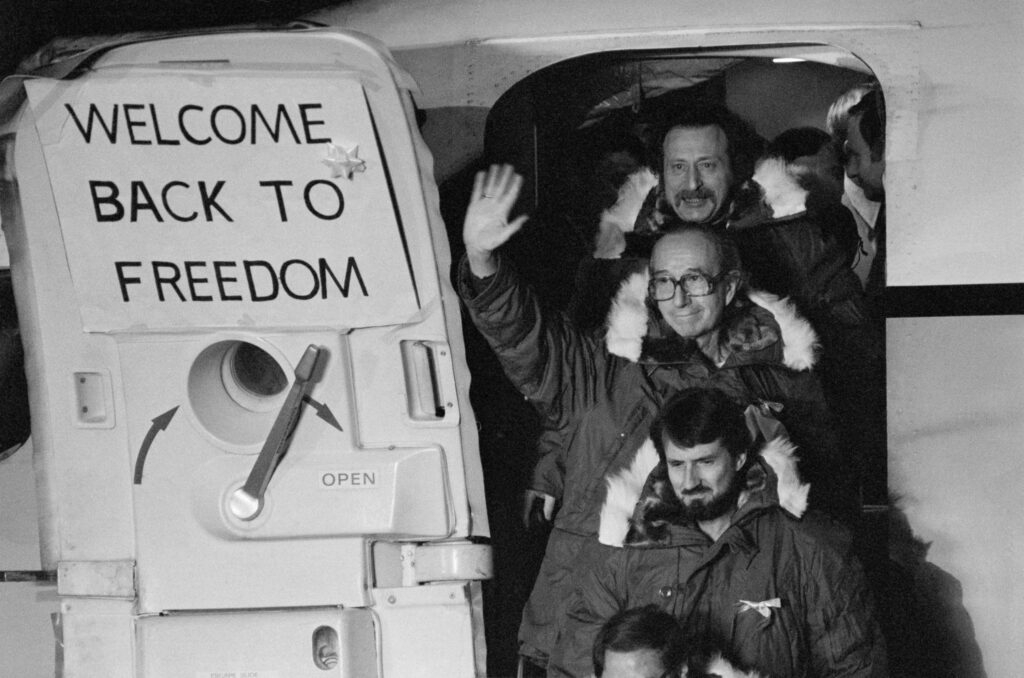For 444 days between 1979 and 1981, 52 American citizens and diplomats who once worked at the U.S. Embassy in Tehran were held hostage by Iranian college students loyal to Iran’s revolutionary Islamic cleric, Ayatollah Ruhollah Khomeini. Though no hostages died, the incident severed U.S.-Iranian relations that have never been restored. It is the date the hostages were finally released that leads many to believe it was more than negotiations that caused their release.
Reagan’s Inauguration: The Ronald Reagan Effect
All 52 hostages were released the day Ronald Reagan was inaugurated as the 40th President of the United States. Legend has it that the Gipper’s rhetoric and forcefulness struck such fear into the hearts of the Ayatollah’s revolutionary government that they were immediately compelled to send the hostages home. It’s true that the hostages were released on January 20, 1981, the same day Reagan was inaugurated as President, but it had nothing to do with fear of Ronald Reagan.

Iranian students stormed the U.S. embassy in Tehran not long after Shah Mohammad Reza Pahlavi, whose regime had just been overthrown in Iran, was admitted to the United States for cancer treatment. Iranians wanted to put him on trial for the crimes of his dictatorial regime. Iranians also believed the United States might reinstate the Shah, an act they had been complicit in during a similar crisis in 1953.
Carter’s Diplomacy and the Aftermath of the “Reagan Scare”
For the rest of his Presidency, Jimmy Carter and his administration would have to negotiate with an erratic, unpredictable, and unaccountable revolutionary government. Still, they did so, working with Algeria as a mediator. Carter became consumed by the negotiations and by getting the hostages home. The result was the Algiers Accords, an agreement signed by the two parties the day before Reagan’s inauguration.

But the timing of the agreement wasn’t entirely coincidental. The Iranian government needed to get a deal done before Reagan came into office because Reagan claimed he would never negotiate. And Tehran did have a lot of spite toward Jimmy Carter. He was the face of the United States during the final years of the Shah’s regime, and it didn’t matter that the extent of Carter’s relationship with the Shah was just two years in a span of decades.

According to journalist MMark Bowden’s book “Guests of the Ayatollah,” the Iranian government wanted to deny Carter the chance to address the American public and tell them the hostages were coming home. They wanted Reagan to get credit for their safe return, and the move worked. Carter was soundly defeated in his bid for reelection, and the myth that Ronald Reagan struck fear into the hearts of Iranian revolutionaries persists to this day, still painting Carter as relatively weak.
None of that mattered to President Carter, however. Though his refusal to bomb Tehran or be more militarily aggressive toward Iran was met with derision from the American people and from many in his own White House, Carter maintained that not one of the hostages were lost, and they certainly would have been killed in the event of a military strike.
He did authorize one military rescue mission: the failed Operation Eagle Claw. It was an overly complex special operations mission that was ultimately aborted after it cost the lives of eight U.S. service members. Rather than cause the deaths of thousands more Iranian civilians and American troops, the President reasoned, it was better to continue negotiating their release.
When the hostages arrived in the U.S. Air Force hospital in Wiesbaden, West Germany, former President Jimmy Carter was waiting there to greet them. At least one of the hostages snubbed the President, while most agreed that not getting them killed was the right thing to do, even though it cost him the White House.
Read About Other Military Myths and Legends
If you enjoyed learning about whether Ronald Reagan scared Iran into freeing hostages, we invite you to read about other military myths and legends on our blog. You will also find military book reviews, veterans’ service reflections, famous military units and more on the TogetherWeServed.com blog. If you are a veteran, find your military buddies, view historic boot camp photos, build a printable military service plaque, and more on TogetherWeServed.com today.

This attempt to glorify Jimmy Carter fails to impress me.
Carter was a good man but a lousy president.
The Reagan years were wonderful compared to Carter’s
Carter was NOT weak. The power of intelligence and perseverance while sacrificing his own reputation was nothing to Jimmy Carter. Admittedly, Reagan was a great president for what we needed at that juncture in time but Carter was a quietly powerful man. If you don’t see that already, you never will.